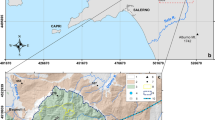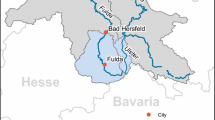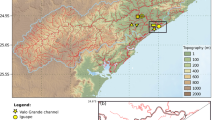Abstract
Long-term discharge characteristics and their variability provide basic information on the availability of surface water. Because discharges are measures at a limited number of gauges within a drainage network, a regionalisation procedure is needed in order to get a complete picture of the spatial distribution of discharge in the catchment. The following discharge characteristics are taken into account here: minimum discharge (NQ), 25th percentile (Q25), 50th percentile (Q50), mean discharge (MQ), 75th percentile (Q75) and maximum discharge (HQ). The regionalisation method developed is based on the close statistical relationship between the logarithmic cumulative stream length and the logarithmic discharge characteristic in the Upper Danube drainage basin. All measures are calculated for the reference period from January 1980 to December 1999. Map 15.1 presents the regionalised mean discharge MQ and its variability, determined from the quotient of regionalised values of NQ and HQ. Primarily, it is alpine tributaries such as the Iller, Lech, Isar and Inn Rivers that influence the drainage patterns of the Danube.
Access provided by Autonomous University of Puebla. Download chapter PDF
Similar content being viewed by others
Keywords
1 Introduction
The term discharge refers to the volume of water per unit time that flows through a defined cross-sectional area within a stream. Discharge rate is given by dividing by the appropriate area of the drainage basin. The regional patterns of distribution for the mean annual discharge provide the basic data on the availability of surface water. Information about the range of the discharges at a given site describes the discharge variability that is calculated here using the quotient of flood discharge (HQ) and low flow discharge (NQ).
Discharges are measured at a limited number of gauges within a drainage network. If discharge values are required for unmeasured cross-sectional areas, then an appropriate transfer of the measurements is needed (regionalisation). As a result, the discharge values (MQ, HQ, etc.) can be determined for every required point within the drainage network using the regionalisation method developed for the surface water subproject. An additional step yields the discharge variability for the entire Upper Danube drainage basin. This also provides the input data for the model parameterisation for the surface water subproject (see Chap. 29). The regionalisation method allows statements to be made about the runoff characteristics of unobserved sections in the drainage network. This evidence can be used in the planning of hydraulic engineering facilities, for industrial, public and private water consumption or for river navigation purposes. Significant changes in mean discharges and discharge variabilities that are induced by global climate change, for example, may lead to far-reaching consequences within the environment. There are already trends in the changes in discharge data that can be detected today (KLIWA 2000).
2 Data Processing
The establishment of the regionalisation method requires discharge data from as many gauges as possible within the drainage basin. Thus, series of mean daily discharge are used as data base that have been made available from the Bavarian State Office for the Environment (Bayerisches Landesamt für Umwelt = LfU); the Baden-Württemberg State Office for the Environment, Measurements and Nature Conservation (Landesanstalt für Umwelt, Messungen und Naturschutz Baden-Württemberg = LUBW); and the Austrian Federal Ministry for Agriculture, Forestry, Environment and Water Management (Bundesministerium für Land- und Forstwirtschaft, Umwelt- und Wasserwirtschaft Österreich = BMLFUW). These series of data were first used to calculate principal primary statistics for hydrological variables (e.g. minimum discharge NQ, mean discharge MQ, peak discharge HQ) for each gauge. Then regression equations were compiled in order to regionalise these aggregated values based on general and area-wide features. Figure 15.1 shows the values for NQ, MQ and HQ determined using the series of data on mean daily discharges for the period from January 1980 to December 1999.
Mean daily discharge and discharge variability (Data sources: DANUBIA – river network; Discharge Data © Bayerisches Landesamt für Umwelt, www.lfu.bayern.de; State Office for the Environment, Measurements and Nature Conservation Baden-Württemberg (LUBW), Karlsruhe, 1999; Austrian Federal Ministry for Agriculture, Forestry, Environment and Water Management, BMLFUW, Vienna, 1999, Jarvis et al. 2008)
The regionalisation method developed within the surface water subproject for determining discharge values is based on the close statistical relationship between the logarithmic cumulative flow length (LC) and the logarithmic discharge (Q) in the Upper Danube drainage basin.
Figure 15.2 shows this relationship based on the mean discharges (MQ) in a log-log graphical representation. The coefficient of determination here is 0.95.
The parameters c1 and c2 for the following six hydrological variables are given in Table 15.1: minimum discharge (NQ), 25th percentile (Q25), 50th percentile (Q50 is equivalent to the median), mean discharge (MQ), 75th percentile (Q75) and peak discharge (HQ). The hydrological variables for each point in the Upper Danube drainage network can be calculated based on the regression parameters, since the cumulative flow lengths are known for each point.
3 Results
The regionalised mean discharge (MQ) and discharge variability, determined from the quotient of regionalised values of NQ and HQ, are presented. The mean discharge is classified into five categories that are represented by different line thicknesses. Discharge variability is divided into six classes. These variabilities are distinguished on Map 15.1 by different colours.
Mean discharge increases with increasing size of the drainage basin. Where tributaries merge with the main watercourse, there is a significant increase in discharge. Primarily, it is alpine tributaries such as the Iller, Lech, Isar and Inn rivers that influence the runoff characteristics of the Danube. Thus, in early summer, extreme discharges from alpine snowmelts occur that can lead to high water levels in the Danube. However, also the inflows from northern low mountain ranges and lowlands contribute to elevated discharges in the Danube during long-lasting rainfalls. In addition to spatial variability, the range of the discharges also varies. There are highly variable discharges in the smaller drainage basins and in the headwaters of the water bodies. Variability decreases with increasing size of the drainage basin, because extreme situations can be better compensated for.
References
Jarvis A, Reuter HI, Nelson A, Guevara E (2008) Hole-filled seamless SRTM data V4. International Centre for Tropical Agriculture (CIAT). Available from http://srtm.csi.cgiar.org
KLIWA (ed) (2000) Klimaveränderung und Konsequenzen für die Wasserwirtschaft. Fachvorträge beim KLIWA-Symposium am 29. und 30.11.2000 in Karlsruhe. KLIWA-Berichte, Heft 1, Karlsruhe
Author information
Authors and Affiliations
Corresponding author
Editor information
Editors and Affiliations
Rights and permissions
Copyright information
© 2016 Springer International Publishing Switzerland
About this chapter
Cite this chapter
Willems, W., Kasper, G., Klotz, P., Stricker, K., Zimmermann, A. (2016). Mean Daily Discharge and Discharge Variability. In: Mauser, W., Prasch, M. (eds) Regional Assessment of Global Change Impacts. Springer, Cham. https://doi.org/10.1007/978-3-319-16751-0_15
Download citation
DOI: https://doi.org/10.1007/978-3-319-16751-0_15
Publisher Name: Springer, Cham
Print ISBN: 978-3-319-16750-3
Online ISBN: 978-3-319-16751-0
eBook Packages: Earth and Environmental ScienceEarth and Environmental Science (R0)







